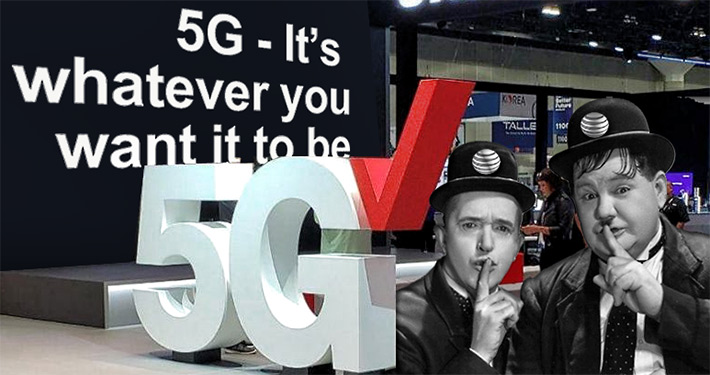
The advertising industry’s self-regulatory organization has suggested that Verizon should stop claiming that it has America’s first 5G network, but Verizon claims that its “first to 5G” commercials are not misleading and is appealing the decision.
The National Advertising Division (“NAD”) determined that, in the context of two challenged television commercials touting Verizon’s rollout of 5G service in sports venues, the claim that “Verizon is building the most powerful 5G experience for America” reasonably communicates a message about the consumer experience of using 5G mobile service that was not supported by the evidence in the record.
Therefore, NAD recommended that Verizon discontinue the claim that it is delivering “the most powerful 5G experience for America.” Verizon said that it will appeal this adverse finding to the National Advertising Review Board (NARB). NAD also recommended that the advertiser modify the challenged advertising to ensure that disclosures regarding 5G coverage both inside and outside the touted sports venues are clear and conspicuous (e.g., that Verizon’s 5G service will be available in parts of the sports venues; and that it is available only in parts of select cities). The claims were challenged by AT&T Services, Inc., provider of competing wireless services.
NAD is an investigative unit of the advertising industry’s system of self-regulation and is a division of the BBB National Programs’ self-regulatory and dispute resolution programs.
The following are representative of the challenged claims:
Express Claim
- “Verizon is building the most powerful 5G experience for America.”
Implied Claims
- Verizon customers will experience the “massive capacity of 5G with ultra-wideband so more streaming, screaming, posting fans can experience 5G all at once” in stadiums and arenas with 5G.
- Verizon’s market-leading 5G performance and “massive capacity” is available to Verizon customers wherever it currently offers or will offer 5G, including outside stadiums and arenas.
- Verizon’s mmWave 5G service and the claimed performance benefits (most powerful experience, ability to provide claimed benefits to thousands of people simultaneously) will be available wherever Verizon’s 5G advertisements are shown.
NAD determined that in the context of the challenged advertising, at least one message reasonably conveyed to consumers by the express claim that “Verizon is building the most powerful 5G experience for America” is the present tense message that Verizon is delivering “the most powerful 5G network for America.” NAD noted that this present tense message is conveyed by visuals of fans in sports venues, and that it is also conveyed by the present tense and even past tense language: the sports venues chose Verizon (past tense) because it is building the most powerful 5G experience.
“This is happening now,” for the NFL. In basketball arenas, it is happening “soon” and “this season.” If Verizon can do this, “imagine what it can do for you.” “This is 5G built right.” NAD further noted that the 5G experience depicted and described is the experience of thousands of people attending the same sports event and sharing that experience. Consumers are asked to view this experience and “imagine what it can do” for them in the present.
With regard to the evidence needed to support Verizon’s unqualified superiority claim, NAD noted that the challenged advertising goes beyond touting Verizon’s spectrum portfolio and reasonably communicates a message about the consumer experience of using 5G mobile service, both with regard to capacity (i.e., the ability to serve a large number of people at once) and usage (i.e, using Verizon’s 5G network to post content, an activity that relies upon a network’s upload and download speeds). Further, in the context of these advertisements, the word “power” conveys a message not only about speed but also potentially about, for example, resilience, coverage, and the reaction time of the network (i.e., latency).
After reviewing Verizon’s evidence, NAD concluded that it was insufficient to support Verizon’s present tense “most powerful network” claim. Therefore, NAD recommended that Verizon discontinue the claim that it is delivering “the most powerful 5G experience for America.”
AT&T also challenged three implied claims regarding the availability of Verizon’s 5G service in the sports venues themselves and outside the sports venues.
NAD concluded that both the express language of the video advertisements as well as the images reasonably convey the message that Verizon customers will experience the “massive capacity of 5G with ultra-wideband so more streaming, screaming, posting fans can experience 5G all at once” in stadiums and arenas with 5G. Although both the challenged advertisements contain the disclosure that Verizon’s 5G service will be available in “parts of” the sports venue, NAD determined that the disclosures were not conspicuous. Therefore, NAD recommended that Verizon modify the challenged advertising to ensure that the disclosures regarding 5G coverage in the touted sports venues are clear and conspicuous.
Further, NAD determined that the advertising conveys a message about Verizon’s 5G service outside of the touted sports venues. NAD has determined that when advertising conveys a message that a product or service is available, the limited availability of the touted service is a material fact which must be clearly and conspicuously disclosed. Although the two advertisements contain disclosures, NAD noted that only one of them contains a disclosure concerning the availability of Verizon’s 5G service outside of sports venues. NAD also had concerns regarding the prominence and clarity of the disclosures, which appear at the busiest moment of each commercial, with a sport event in progress, in small white text on a rapidly changing background, for a brief time. Therefore, NAD recommended that Verizon modify the challenged advertising to include a clear and conspicuous disclosure regarding the availability of Verizon’s 5G service outside of the touted sports venues – for example, that Verizon’s 5G service is “available only in parts of select cities.”
In its advertiser’s statement, Verizon stated that it will comply with NAD’s recommendations regarding the clarity and conspicuousness of disclosures, however it will appeal a portion of NAD’s decision. Verizon stated that it “will appeal NAD’s contention that the claim ‘Verizon is building the most powerful 5G experience for America,’ in the context of the Stadium Access commercials, conveys a claim that Verizon is currently ‘delivering the most powerful 5G experience for America.’ The intent of the commercial is to inform consumers about the billions of dollars Verizon is investing in its 5G buildout. Verizon strongly believes that consumers understand that this is the only message that is reasonably conveyed.”
Verizon’s said it “believes NAD failed to properly evaluate the net impression of the challenged commercials” and “disagrees that the challenged claims or net impression of the commercials at issue convey anything more than corporate pride in its achievements and the development of its next generation 5G Ultra-Wideband Network.”
Verizon also said it “disagrees that reasonable consumers are likely to misunderstand its claims about its ‘5G Ultra-wideband network,’ which is unique from networks under development by other carriers.
Competitive marketing surfaced last year in Sprint’s lawsuit against AT&T for deceptively marketing its upgraded 4G service as “5G Evolution.” It was settled, ending what was considered a PR ploy.














